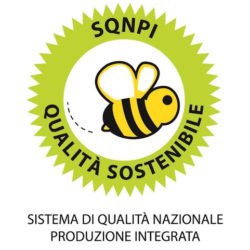
Casale Vitali have 20 hectares of existing vineyards. There are large vineyards planted right below the cantina and others close by in Montelparo including Celestiale, Santa Maria and Cortaglie areas. There are more vineyards in Monte Rinaldo in the Cuma area.
The vines are planted in a medium textured soil, predominantly limestone, some on steeply sided slopes between 300 – 450 metres above sea level. The land is very fertile with a lot of natural springs.
The grass, clover and wildflowers are allowed to grow between the rows of vines for good biodiversity. These are cut late summer to feed the vines. Sheep are grazed through the vineyards in the winter months which adds to soil nutrient.
We undertake sustainable agricultural practices with low environmental impact.
The temperate climate is beneficial for growing good quality grapes set between the Adriatic coast and the Sibillini mountains, just 30 kms from the coast so we have good airflow. Many Marche varieties of grape favour the range of temperatures between night and day.
We grow the typical varieties of this Marche region from the white Passerina and Pecorino to the red Sangiovese, Montepulciano and Lacrima.
The vines require different planting positions, with the white varieties needing a north/north east aspect while the reds prefer a south/south east aspect
Over the years we have studied the vines and grapes and changed the cultivation and harvesting and the production of new wines accordingly.
We saw that the Sangiovese grapes have a different ripening time from the Marche Sangiovese. Our altitude and proximity to the mountains creates a different formation of the buds in the spring.
We have grapes ripening at different times at harvest time: for this reason, we decided to make a different wine from Sangiovese. At first we developed the sparkling Brut Montilli with 50% Sangiovese and 50% Passerina with a fantastic result.
We created a new white wine called Deviango from 100% Sangiovese.
We studied the Montelpuciano grapes which have difficulty ripening, we experimented firstly by leaving them on the vines longer to ripen and dry before harvesting and then secondly to harvest earlier and allow them to ripen in large wooden boxes protected from the weather. This grape is used in the Giugio wine at 10% and 100% in the sweet red dessert wine T’Amando.

